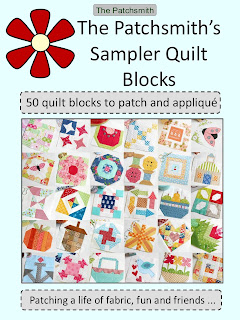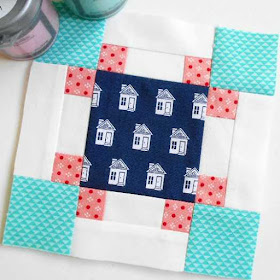Nearly every town in England has a road called London Road. It was along these roads that the suffragettes marched towards London a century ago. Hence the four arrows leading in the same direction around a central square in the London Roads block.
This block is my favourite block from the book. It is so pretty and once you have got the hang of Skinny Triangles it goes together quite easily as I have designed it so that it doesn’t need matching seams.
So how to do those SkinnyTriangles. I was first introduce to
Skinny Triangles a long time ago by Karen Hellaby and a great little book called ‘Sew a Row Quilts’. Skinny Triangles are perfect for this block and I have a little tip to help you get them just right.
For each arrowhead you will need two (C) background rectangles with marked diagonals which are a mirror image of each other.
 |
| Follow steps 2 and 4 to create these rectangles |
You will also need to mark the (D) arrowhead rectangles as detailed in step 2 of the pattern. Once done you are ready to sharpen the arrowhead.
Firstly, with right sides together, lay the background rectangle with the mark running from the top right-hand corner to the bottom left onto the (D) rectangle so that the diagonal line runs from the mark at the top of the (D) rectangle down to the bottom right-hand corner as shown.
Pin to keep the pieces in place to stop them slipping whilst stitching.
Then stitch along the marked line.
You are now ready to trim and press the triangle open and here is my tip:
finger press the corner open BEFORE trimming the corner. This is to ensure that the skinny corner covers the corner of the (D) rectangle
completely before you trim the fabric. If your stitching is not accurate you may
find the (C) corner does not completely cover the corner and you will be able to unpick and restitch the skinny triangle if you have not trimmed it.
 |
| You can see that the Skinny Corner covers the background rectangle completely. |
Once you are happy with your corner, trim it .....
and press it open ....
 |
| One Skinny Triangle complete |
Now you can make a mark along the top edge as detailed in step 4.
With right sides together, lay the background rectangle with the mark running from the top left-hand corner down to the bottom right corner onto the arrowhead unit so that the diagonal line runs from the mark on the top edge down towards the bottom left-hand corner.
Pin and stitch before trimming
and pressing (remember the tip – it works this side as well).
The arrowhead unit should measure approximately 2½” x 3”. You can now trim the bottom of the arrowhead
unit to create an arrowhead that measures 2½” square.
 |
| Trim the bottom of the arrowhead to size (I have turned it on its side in the photo) |
Once you have made all four arrowheads it is a simple case of stitching the block together. And there you have it – a London Roads block.
 |
| Join the blocks into rows and the rows into one London Roads block |
And remember - three arrows make a great sidebar to turn any of the blocks from the book into a fun mug rug.
 |
| Three Arrows Sidebar turns block 9 'Bullseye' into a fun mug rug |
As this is my most favourite block from the book I thought it might be a nice treat for me to share the cutting sizes/instructions to make a 12” London Roads block (finished size).
To create a 12” (finished size) London Roads block cut:
A – One 4½” center square
B – Eight 1¾” x 4½” background
rectangles
C – Eight 2½” x 5” background
rectangles
D – Four 4½” x 5”
rectangles (arrowheads)
E – Four 2” x 4½”
rectangles (arrow tails)
Follow the pattern. At step 2 make a mark on the D rectangle 2½” in from the right-hand side and at step 4 make the mark 2½” in from the left-hand side. At step 6 trim the bottom of the arrowhead so that the finished arrowhead is 4½” square.
I hope you'll have a go at Skinny Triangles as we use them again for Block 34 - Birdhouse. Until then share your London Road blocks over on the Instagram (#block17londonroads) or in the Flickr Group. Until next time .....





































